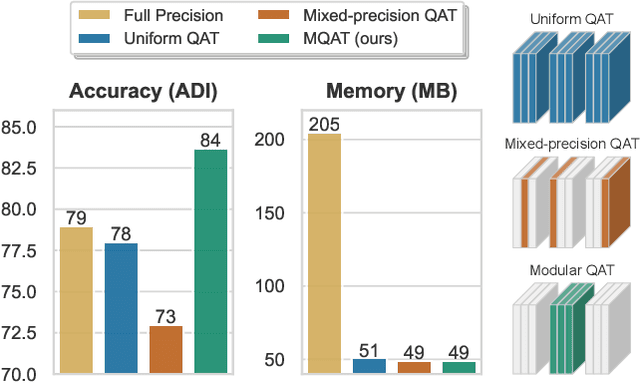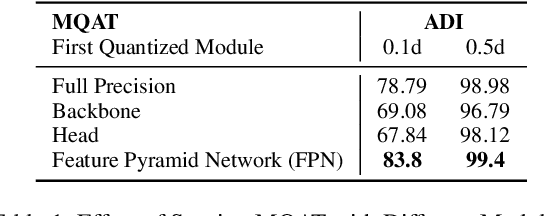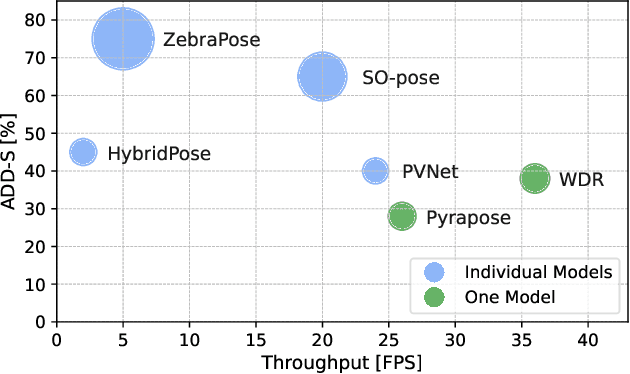Saqib Javed
Temporally Compressed 3D Gaussian Splatting for Dynamic Scenes
Dec 07, 2024Abstract:Recent advancements in high-fidelity dynamic scene reconstruction have leveraged dynamic 3D Gaussians and 4D Gaussian Splatting for realistic scene representation. However, to make these methods viable for real-time applications such as AR/VR, gaming, and rendering on low-power devices, substantial reductions in memory usage and improvements in rendering efficiency are required. While many state-of-the-art methods prioritize lightweight implementations, they struggle in handling scenes with complex motions or long sequences. In this work, we introduce Temporally Compressed 3D Gaussian Splatting (TC3DGS), a novel technique designed specifically to effectively compress dynamic 3D Gaussian representations. TC3DGS selectively prunes Gaussians based on their temporal relevance and employs gradient-aware mixed-precision quantization to dynamically compress Gaussian parameters. It additionally relies on a variation of the Ramer-Douglas-Peucker algorithm in a post-processing step to further reduce storage by interpolating Gaussian trajectories across frames. Our experiments across multiple datasets demonstrate that TC3DGS achieves up to 67$\times$ compression with minimal or no degradation in visual quality.
Self-Ensembling Gaussian Splatting for Few-shot Novel View Synthesis
Oct 31, 2024



Abstract:3D Gaussian Splatting (3DGS) has demonstrated remarkable effectiveness for novel view synthesis (NVS). However, the 3DGS model tends to overfit when trained with sparse posed views, limiting its generalization capacity for broader pose variations. In this paper, we alleviate the overfitting problem by introducing a self-ensembling Gaussian Splatting (SE-GS) approach. We present two Gaussian Splatting models named the $\mathbf{\Sigma}$-model and the $\mathbf{\Delta}$-model. The $\mathbf{\Sigma}$-model serves as the primary model that generates novel-view images during inference. At the training stage, the $\mathbf{\Sigma}$-model is guided away from specific local optima by an uncertainty-aware perturbing strategy. We dynamically perturb the $\mathbf{\Delta}$-model based on the uncertainties of novel-view renderings across different training steps, resulting in diverse temporal models sampled from the Gaussian parameter space without additional training costs. The geometry of the $\mathbf{\Sigma}$-model is regularized by penalizing discrepancies between the $\mathbf{\Sigma}$-model and the temporal samples. Therefore, our SE-GS conducts an effective and efficient regularization across a large number of Gaussian Splatting models, resulting in a robust ensemble, the $\mathbf{\Sigma}$-model. Experimental results on the LLFF, Mip-NeRF360, DTU, and MVImgNet datasets show that our approach improves NVS quality with few-shot training views, outperforming existing state-of-the-art methods. The code is released at https://github.com/sailor-z/SE-GS.
QT-DoG: Quantization-aware Training for Domain Generalization
Oct 08, 2024



Abstract:Domain Generalization (DG) aims to train models that perform well not only on the training (source) domains but also on novel, unseen target data distributions. A key challenge in DG is preventing overfitting to source domains, which can be mitigated by finding flatter minima in the loss landscape. In this work, we propose Quantization-aware Training for Domain Generalization (QT-DoG) and demonstrate that weight quantization effectively leads to flatter minima in the loss landscape, thereby enhancing domain generalization. Unlike traditional quantization methods focused on model compression, QT-DoG exploits quantization as an implicit regularizer by inducing noise in model weights, guiding the optimization process toward flatter minima that are less sensitive to perturbations and overfitting. We provide both theoretical insights and empirical evidence demonstrating that quantization inherently encourages flatter minima, leading to better generalization across domains. Moreover, with the benefit of reducing the model size through quantization, we demonstrate that an ensemble of multiple quantized models further yields superior accuracy than the state-of-the-art DG approaches with no computational or memory overheads. Our extensive experiments demonstrate that QT-DoG generalizes across various datasets, architectures, and quantization algorithms, and can be combined with other DG methods, establishing its versatility and robustness.
Module-Wise Network Quantization for 6D Object Pose Estimation
Mar 12, 2023



Abstract:Many edge applications, such as collaborative robotics and spacecraft rendezvous, can benefit from 6D object pose estimation, but must do so on embedded platforms. Unfortunately, existing 6D pose estimation networks are typically too large for deployment in such situations and must therefore be compressed, while maintaining reliable performance. In this work, we present an approach to doing so by quantizing such networks. More precisely, we introduce a module-wise quantization strategy that, in contrast to uniform and mixed-precision quantization, accounts for the modular structure of typical 6D pose estimation frameworks. We demonstrate that uniquely compressing these modules outperforms uniform and mixed-precision quantization techniques. Moreover, our experiments evidence that module-wise quantization can lead to a significant accuracy boost. We showcase the generality of our approach using different datasets, quantization methodologies, and network architectures, including the recent ZebraPose.
 Add to Chrome
Add to Chrome Add to Firefox
Add to Firefox Add to Edge
Add to Edge